JESSE H. STEVENSON
The Fifth Commandment of the Bible is that we honor father and mother. This is presented as a Tribute to my own father.
Jesse Horace Stevenson was born on December 29, 1920 in Sweetwater, Texas. Both his mother and father had been born in Texas. His grandfather Stevenson had left Georgia and had come to Texas to escape the Civil War. The Fomby's traced their family history all the way back to the Mayflower.
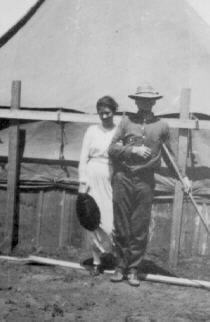
His father was Thomas Horace Stevenson. His mother was Rachel Katherine Fomby (Stevenson). His brothers and sister were...
1. Joel Matthew Stevenson.
2. Rose Marie Stevenson.
3. "Rusty" Minnie Katherine Stevenson.
4. Thomas Stinson Stevenson.
5. Henry Forest Stevenson.
They lived a rural life on the edge of a small town in Texas. Thomas Stevenson was a carpenter who, during the Depression, sought to care for his family by looking for various sorts of work. One of Jesse's early memories was of a cattle drive in a covered wagon during which his younger brother Joel was born.
They were a poor family and Jesse described himself as having to walk to school. He had bouts with sickness such as tuberculosis which left him sickly.
It was an eighth grade math teacher who later introduced him to flying. He received a Student Pilot Certificate on March 3, 1941. The Certificate shows that he lived at 809 Lamar Street, Sweetwater, Texas. He was 6'2" and weighed only 140 pounds. By May 20, 1941, he had become qualified to make his first solo flight.
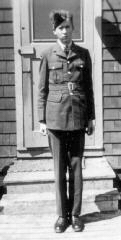
World War 2 had broken out and before it was over, both Jesse and two of his brothers would fly combat missions. His brother Joel survived being shot down over Europe, capture, a German death sentence and eventual escape back to Allied lines.
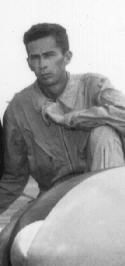
Early in the war, Jesse tried to enlist in the United States Air Force and was rejected due to his poor medical history. Undaunted, he traveled north to Canada to enlist in the Royal Canadian Air Force. He was placed into a squadron of people like himself who were considered misfits and rejects.
A number of old planes were shipped from England for his squadron to use for training - half of them never made their destination. Those that did were to serve as training planes for the squadron. Jesse took to flying with a vengeance and would later describe such misadventures as flying under bridges or under telephone lines as he learned the lessons of being a combat pilot.
One story involved a practice low-level bombing run in which the TNT had been removed from the bomb, making it lighter than usual. As he flew over the water and dropped the bomb on the target, the bomb skipped on the water like a boy skipping a stone and bounced back up into the plane, wedging itself in the bombay doors. The magnesium signal flare on the bomb went off, catching the plane on fire, though Jesse landed without further incident.
On another instance, Jesse found the engines of his plane stall as he was approaching the face of a cliff. He thought that he was facing certain death with a head-on collision when suddenly the air currents lifted up his plane and set it with a thud on the cliff top. He later felt that it had been the hand of the Lord which plucked up his plane and brought it to safety.
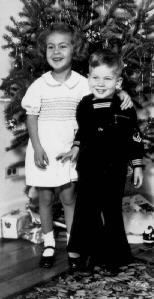
Jesse met Mary Rosetta Sinclair, daughter of a Scottish Baptist who lived in Vancouver. They were married in Canada and had three children.
1. Donna Marie Stevenson: Born on Victoria Island, Canada on July 29, 1943.
2. David Michael Stevenson: Born in Everett, Washington on November 2, 1945.
3. Dennis Wayne Stevenson: Born in San Antonio, Texas.
Jesse transferred to the United States Air Force in 1944. He was transferred to San Francisco for further training in flying, camera gunnery, ground gunnery and aerial gunnery.
Jesse was not the only Stevenson to fly in World War 2. Joel also flew for the Royal Canadian Air Force and was shot down over Europe, was captured, escaped, was captured again and escaped again to make his way back to friendly territory. Thomas flew the B-36 in the United States Air Force and Henry Forrest served as an Air Force navigator.
In May 1945 Jesse was shipped out to the South China Sea where the Japanese were tenaciously holding out. On May 30, 1945 he flew his first combat zone in the Pacific. By July he was flying combat missions, strafing and bombing military targets. The following is merely a partial representation of his log book for this period.
|
Date |
Plane |
Log Entry |
|
6/1/45 |
P-61A |
First "night cap" in CZ |
|
6/17/45 |
P-61A |
Airfields & towns - light AA |
|
7/28/45 |
P-61B |
First combat mission (satisfactory) - Okinawa |
|
8/7/45 |
P-61B |
Poor visibility - strafed all targets |
|
9/1/45 |
P-61B |
Flying convoy cover. Buzzed destroyer with permission. |
On August 6, 1945 the United States dropped the first Atomic Bomb on Hiroshima. Three days later they followed this with a second Atomic Bomb on Nagasaki, bringing the war to a quick conclusion. With the war's end, Jesse was transferred to Okinawa for several months. He returned to the United States in November, 1945.
Dennis Wayne died in August, 1949. He was only 17 months old.
After the death of Dennis Wayne, Jesse & Mary's marriage went downhill. Jesse sought to deal with the grief by plunging himself into his work (he was only a master sergeant and was struggling up the promotional ladder). They divorced on Jesse's birthday, 1949.
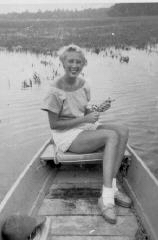
Jesse met Carmen Minerva Santiago at a New York dance in December 1951. He asked her to dance and she found him a good dancer. He asked to take her home, but she slipped out the back way. Demonstrating a characteristic persistence, he phoned her at work and asked her out. They dated throughout December and January and were married on February 1, 1952. Their honeymoon consisted of a trip to Texas that involved a fishing trip. It was quite a shock for this city girl.
He was being transferred to Texas and they traveled there and then spent several months traveling to Kansas, Pensacola, and finally settling in Washington D.C. There was both a "hot" war as well as a "cold" war brewing with enemies in Russia and China.
The Korean War was spent in the United States as an IP (Instructor Pilot) in the F-86, which Jesse later described as his favorite airplane.
With Carmen, he had two sons:
1. John Thomas Stevenson: Born in Washington D.C. on September 1, 1953.
2. Dennis Stevenson: Born in England on October 17, 1957.
While his family was in England, he was sent to North Africa for a tour of several months. Returning to the United States in 1958, Jesse was stationed at Wright Paterson Air Force Base in Ohio. It was at this time that David and Donna came to live with him, bringing to total number of children in the Stevenson household to four.
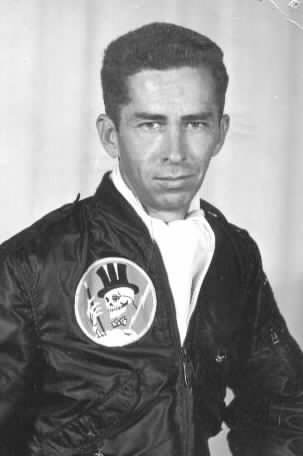
In 1961, he was transferred to K.I. Sawyer Air Force Base in Northern Michigan. This time, the family lived on Base housing, staying for a year in a two-story townhouse with a full basement.
In 1962, he was to be transferred to Viet Nam. He first moved his family to Miami where they purchased a house. In Viet Nam he was a military advisor involved in setting up a communications net. It was here that he received a purple heart for a wound sustained when an explosive device went off in a building in which he was an occupant.
Returning to the States in 1963, the family moved to Eglin Air Force Base. This was to be Jesse's last year in the Air Force due to down-sizing among the officers and a resultant forced retirement.
On his last flight for the Air Force, he had control trouble with a plane and narrowly missed crashing. He was advised by the control tower to bail out, but he responded in the negative and landed the plane safely. He was awarded a medal and given a letter of citation from General of the Air Force Curtis Lemay for having saved the expensive aircraft.
Returning to Miami after his retirement, Jesse bounced through several jobs in seeking to supplement the income of his family. He worked as a bus driver and for an electronics company before going back to school to get a B.A. in education from University of Miami (also taking classes at Dade Junior and FAU). After obtaining his degree, he taught 5th grade elementary school for two years before his illness came upon him.
* * * * *
What kind of man was Jesse? You don't normally think of such things as a child - your father merely is your father. It was not until he was advanced in years that I was able to begin to get to know him.
He was a man who was comfortable with himself. He wasn't afraid to be alone. There are those who must always surround themselves with activity and people and noise. He wasn't one of them. Although somewhat introverted, he was comfortable in large groups and was involved in church.
He was a man of conviction and a man of principle. There were times when he was passed over for a promotion because he wasn't afraid to stand up and speak when he thought he was right. This made him appear argumentative at times.
He was also a man of God. He attended church with a persistent regularity and, encouraged by his wife, led his family in daily reading of the Bible and in prayer. He taught a boy's Sunday School class, even at a time when he knew very little Bible and had to resort at times to telling old war stories.
I can remember flying over Miami with my father in a small Cessna. He seemed delighted that he could share his love of flying with his son and when I considered going to ROTC for training in the Air Force, he was ready to encourage me. And yet, when I did not choose that route for my life, he never expressed a regret.
He had a love of flying that stayed with him his entire life. When illness crept in, he would express his thankfulness to the Lord for the years in which he had been able to fly. He was also able to relate with his granddaughter, Sky, and her own love of flying.
He loved the outdoors. Fishing, hunting or merely hiking through a stand of woods were his favorite types of recreation. He dabbled in archery and skiing, in golf and boating, in waterskiing and swimming.
He had a way with animals which seemed almost uncanny. Large or small, they were attracted to his calm and quiet nature. He would gain the trust of a neighborhood squirrel until it would eat out of his hand. I never saw an animal that would not eventually come to him.
He had learned carpentry from his father and he demonstrated both a proficiency and a precision in this exacting trade. He could build a boat or a birdhouse.
He has given to his children and to his grandchildren these things as a heritage. A heritage of peace and of love of God's creation. A heritage of precision and of responsibility toward work and family. And a heritage of faithfulness toward God.
He was my father.
John T. Stevenson